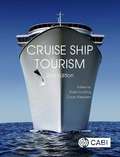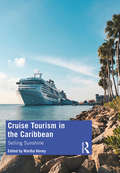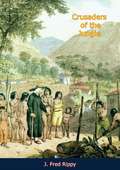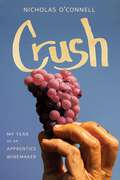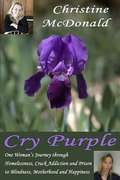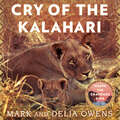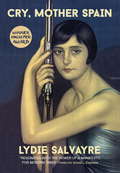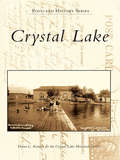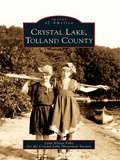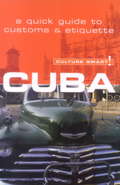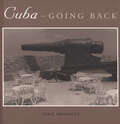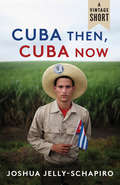- Table View
- List View
Cruise Ship Tourism
by Jo-Anne Lester Ross Dowling James Henry Dr Abel Alonso Dr Michael Lück Dr Lori Pennington-Gray Alexis Papathanassis Clare Weeden Hannah Wood Professor Noel Scott Sandra Wilson Dr Joseph M Cheer Dr Sheree-Ann Adams Professor Michael Clancy Professor Ross A Klein Dr William Terry Professor Xavier Font Dr Mireia Guix Navarrete Dr Maria Jesús Bonilla Dr Jill Poulston Michael P. Vogel Dr Adam Weaver Dr Philip Gibson Dr Maree Thyne Dr Júlio Mendes Dr Manuela Guerreiro Bingjie Liu Dr Peter Tarlow Dr Arja Lemmetyinen Dr Gabriella Polizzi Dr Antonino Mario Oliveri Professor James Petrick Suiwen Zou Dr Kam Hung Dr Claire Lambert Dr Nigel Jarvis Dr Ioannis Pantelidis Nevil Alexander Dr Eloise Botelho Carla Fraga Rodrigo Vilani Dr Michael Shone Dr Jude Wilson Dr David G Simmons Dr Emma J Stewart Dr Gaetano Sabato C Michael Hall Dr Claire Ellis Dr Pascal Scherrer Kaye Walker Dr Daniela Liggett Emad Monshi Dr Marianna Sigala Dr Véronique Mondou Benjamin Taunay Dr Iris MaoCompletely updated and revised, Cruise Ship Tourism, 2nd Edition covers the economic, social and environmental impacts of cruising, combining the latest knowledge and research to provide a comprehensive account of the subject. Despite the industry growing rapidly, there is a substantial gap in the related literature, and this book addresses the key issues for researchers, students and industry professionals. This second edition: - Reviews the fundamental principles of the industry, the cruise experience from a passenger perspective, marketing, planning and destination development. - Includes case studies throughout, translating theory into practical management advice. - Comprises contributions from over fifty international contributors to portray a truly global perspective. - Provides numerous full colour illustrations to bring the subject to life. A valuable 'one-stop-shop' for those interested in cruise ships and maritime tourism, this new edition from major names in the field is also an invaluable resource for anyone concerned more widely with tourism and business development.
Cruise Ship Tourism
by Ross Dowling Clare WeedenCompletely updated and revised, Cruise Ship Tourism, 2nd Edition covers the economic, social and environmental impacts of cruising, combining the latest knowledge and research to provide a comprehensive account of the subject. Despite the industry growing rapidly, there is a substantial gap in the related literature, and this book addresses the key issues for researchers, students and industry professionals. This second edition: - Reviews the fundamental principles of the industry, the cruise experience from a passenger perspective, marketing, planning and destination development. - Includes case studies throughout, translating theory into practical management advice. - Comprises contributions from over fifty international contributors to portray a truly global perspective. - Provides numerous full colour illustrations to bring the subject to life. A valuable 'one-stop-shop' for those interested in cruise ships and maritime tourism, this new edition from major names in the field is also an invaluable resource for anyone concerned more widely with tourism and business development.
Cruise Ship Tourism
by Ross K. DowlingThis book explores the theory, issues, impacts and management considerations surrounding the growing industry of cruise ship tourism. It begins by giving an overview of the cruise industry, followed by chapters focusing on the increasing demand for cruising. It presents case-studies of specific countries, including the Antarctic, Caribbean and Alaska before reviewing the economic, social and environmental impacts of cruise tourism. It concludes by exploring predictions for the future of the industry.
Cruise Ships: The World's Most Luxurious Vessels
by Peter C. SmithThe stunning elegance and luxurious interiors of todays vast fleet of cruise liners remains unrecorded in all but holiday brochures. This book gives a complete overview of the cream of these ships, todays queens of the sea. Each liner is illustrated and described with color illustrations of external and interior views. Details of the design, building and service history of each vessel are provided with vital statistics of the ship and its facilities.Among the ships included are Cunards Queen Victoria and Queen Mary 2, the big new Princess Line liners—Ruby, Grand Sea and Celebrity Eclipse, the two Ocean Village ships and the largest of the P&O liners Ventura, Oceana, Arcadia, Aurora and Artemis. This is a book of reference for maritime enthusiasts, would-be holiday cruisers and those who have been passengers.
Cruise Tourism in Polar Regions: Promoting Environmental and Social Sustainability?
by Michael Luck Patrick T. Maher Emma J. StewartCruises are the primary form of tourism in the Polar Regions and cruise ship tourism in both the Arctic and Antarctic is expanding rapidly. The industry has moved beyond its infancy, and is now entering a maturing phase with increased numbers and types of vessels, more demanding routes, and more regular and predictable patterns of activity. The increase in cruise activities, and the associated risks of accidents, as well as the potential and actual impacts of the large numbers of tourists in the polar regions bring with it management challenges for sustainable use of these regions. This book discusses critically the issues around environmental and social sustainability of the cruise industry in Polar Regions. Authors from Canada, USA, Europe, Australia and New Zealand are experts in their respective fields and take an innovative, critical and at times controversial approach to the subject.
Cruise Tourism in the Caribbean: Selling Sunshine
by Martha HoneyThis book explores the lessons learned from half a century of Caribbean cruise tourism; one of the most popular and profitable sectors of the tourism industry. The modern-day cruise industry dates from the 1960s when the three major cruise lines, Carnival, Royal Caribbean, and Norwegian, set up shop in Florida and began selling winter cruises to the Caribbean targeting American retirees. For geopolitical reasons, the US initially excluded cruises to Cuba. This changed in 2016, following the historic Obama-Castro agreement to move towards diplomatic, trade and travel normalization. Cuba quickly became the Caribbean’s fastest growing cruise destination. This book considers the limited economic benefits of cruise tourism, its environmental and social impacts, and the effects of climate change, and "overtourism." Based on this analysis and case studies of key Caribbean and Mediterranean destinations, this book cautions against overdependence on cruise tourism and outlines reforms needed to bring more benefits and equity to Caribbean countries. It will be valuable to professionals, businesses, development agencies, NGOs, and academics interested in a sustainable cruise industry and the economic well-being of Caribbean island nations.
Cruise Vacations for Mature Travelers
by Kerry SmithIf you're one of the more than five million people who will go on a cruise vacation this year, you may be wondering how to choose between the many cruise lines, ships, and destinations that are available. You may be looking for a cruise geared towards adults, one where both you and the grandkids can have fun, or a cruise on which singles are catered to as much as couples. The key to great vacation is knowing what you need in one convenient place.Looking for an Alaskan cruise in an intimate, Old World-style ship, or a huge ocean liner that can keep all ages happy during a Caribbean family reunion? Cruise Vacations for Mature Travelers helps you, the traveler, determine what kind of cruise experience fits your personality and then tells you how to find it, describing every cruise line and detailing their fleets, ship by ship, so you can choose the perfect vacation! The book also includes tips on budgeting your trip, as well as the options for booking through travel agents, directly with the company, or online. It even helps you choose the best time to travel and the most comfortable cabins.A cruise vacation is an adventure. Make the most of it with Cruise Vacations for Mature Travelers!
Cruisin' the Fossil Freeway: An Epoch Tale of a Scientist and an Artist on the Ultimate 5,000-Mile Paleo Road Trip
by Kirk Johnson Ray Troll"A paleontological odyssey that manages to be informative, witty, educational—and enormous fun." —Simon Winchester, author of The Map That Changed the World, Krakatoa, and A Crack in the Edge of the World An epoch tale of a scientist and an artist on the ultimate 5,000-mile paleo road trip.Cruisin' the Fossil Freeway follows the most unusual travels of a paleontologist and an artist as they drive across the American West in search of fossils. Throughout their journey, they encounter "paleonerds" like themselves, people dedicated to finding everything from suburban T. rex to killer Eocene pigs to ancient fossilized forests. This updated editions brings the text up-to-date on new discoveries, new realizations, and new places, along with new art. A fascinating travelogue, Cruisin' the Fossil Freeway shows us that fossils are everywhere if you learn to look for them—even at 65 miles per hour.
Crusaders of the Jungle
by J. Fred Rippy Jean Thomas Nelson Willis PhysiocA challenge came to the Spanish Kings with the discovery of the New World...a challenge to the conquest of empire for Spain, of souls for “the Holy Mother Roman Catholic Church.” And like the conquistadores, the Spanish padres received the challenge eagerly. Armed with breviary and crucifix, inspired by an undying faith, they went forth to conquer the legions of Satan beyond the Ocean Sea.In South America the padres found no El Dorado, no fabled cities of gold, but only tribes of naked savages dwelling in a “Green Hell.”...The Guarani Indians of Paraguay named their children in a repulsive ceremony at which both parents and children partook of a soup made from the flesh of a prisoner of war...Indians of the Maranon ate such of their relatives as died of sickness....The Mojos often buried their children alive to avoid the burden of rearing them....And the Jibaros decapitated their enemies and shrank their skulls to drive out the soul....It was the perilous duty of the missionaries to persuade these heathen to give up their savage practices without themselves becoming victims. And besides the atrocities of the Indians, the brave friars encountered other severe obstacles....There were countless difficult dialects to be learned....Strange maladies afflicted the padres—Father Fritz suffered a prolonged illness, attended only by an Indian boy and visited by rats and a crocodile....Native food was often repulsive to the Spaniards—Father Lucas de la Cueva with great difficulty overcame his prejudice against food.
Crush: My Year as an Apprentice Winemaker
by Dr. Nicholas O'ConnellIn Crush Nicholas O&’Connell provides a behind-the-scenes look at the daily operations of some of the world&’s most prestigious wineries on the West Coast. This insider&’s view of the wine world includes the intense competition for the best grapes, the bizarre lingo of the tasting rooms, and the visionary winemakers who magically transform grapes into high-end wine. It is a world that includes not only romance and refinement but long hours, backbreaking labor, mind-numbing repetition, and fanatical dedication to quality. Such devotion resulted in the 1973 Stag&’s Leap Wine Cellars Cabernet that won the best red wine at the 1976 Judgment of Paris and transformed the U.S. wine industry. O&’Connell&’s quest to master the art of wine making begins in his garage. From there he embarks on an apprenticeship at Betz and DeLille Cellar and other great wineries in California, Oregon, and Washington. He provides a first-person, ground-up view of a business not yet fully explored despite record interest in wine. O&’Connell also includes conversations with some of the world&’s most gifted vintners, including Warren Winiarski, former owner of Stag&’s Leap Wine Cellars. Wine is surrounded by a seemingly impenetrable cloud of descriptors—&“wet dog,&” &“kumquats,&” &“cat pee&”—and a fog of pretention. Crush pierces this fog with colorful, concrete storytelling, in-depth portraits of famous winemakers, and a lively, down-to-earth description of the process by which wine is made: not in the critic&’s mind but in the winery and vineyard.
Crusin' the Fossil Freeway: An Epoch Tale of a Scientist and an Artist on the Ultimate 5,000-Mile Paleo Road Trip
by Kirk JohnsonThe travels of a paleontologist and an artist as they drive across the American West in search of fossils. Throughout their journey, they encounter "paleonerds" like themselves, people dedicated to finding everything from suburban T. rexes to ancient fossilized forests.
Crusoe
by Katherine FrankIt is January 1719 and Daniel Defoe, almost sixty, sits at a table, writing. He is troubled with gout and debt, but for now is preoccupied with a younger man on a barren shore – Robinson Crusoe, for which he will principally be remembered. Several miles south, an old man, Robert Knox, is bent over a heavy volume. It is Historical Relation, his account of being held captive on Ceylon, published forty years ago after he escaped and returned to England. It has long been out of print, but a copy perhaps sits on the desk of Daniel Defoe as he writes. Where did Crusoe come from? And what is the secret of his endurance? Crusoe explores the intertwined lives of two real men – Daniel Defoe and Robert Knox – and the character and book that emerged from their peculiar conjunction. It is the biography of a book and its hero, the story of Defoe, the man who wrote Robinson Crusoe, and of Robert Knox, the man who was Crusoe.
Cry Purple
by Christine McdonaldThis is the story of the author's journey from almost two decades of prostitution, crack addiction and prison to her present life of blindness, motherhood and happiness.
Cry of the Kalahari (Language Acts and Worldmaking #30)
by Delia Owens Mark Owens'A remarkable story beautifully told... Among such classics as Goodall's In the Shadow of Man and Fossey's Gorillas in the Mist' Chicago TribuneCarrying little more than a change of clothes and a pair of binoculars, two young Americans, Mark and Delia Owens, caught a plane to Africa, bought a thirdhand Land Rover, and drove deep into the Kalahari Desert. There they lived for seven years, in an unexplored area with no roads, no people, and no source of water for thousands of square miles. In this vast wilderness the Owenses began their zoology research, working along animals that had never before been exposed to humans.An international bestseller on original release, Cry of the Kalahari is the story of the Owenses's life with lions, brown hyenas, jackals, giraffes, and the many other creatures they came to know. It is also a gripping account of how they survived the dangers of living in one of the last and largest pristine areas on Earth.---------------------------------'One of the best testimonials to the perseverance, idealism and general spunk of passionate animal students' Washington Post'For anyone interested in animals or in real life adventure, this book is a must' Jane Goodall
Cry, Mother Spain
by Lydie SalvayreAged fifteen, as Franco's forces begin their murderous purges and cities across Spain rise up against the old order, Montse has never heard the word fascista before. In any case, the villagers say facha (the ch is a real Spanish ch, by the way, with a real spit).Montse lives in a small village, high in the hills, where few people can read or write and fewer still ever leave. If everything goes according to her mother's plan, Montse will never leave either. She will become a good, humble maid for the local landowners, muchísimas gracias, with every Sunday off to dance the jota in the church square.But Montse's world is changing. Her brother José has just returned from Lérida with a red and black scarf and a new, dangerous vocabulary and his words are beginning to open up new realms to his little sister. She might not understand half of what he says, but how can anyone become a maid in the Burgos family when their head is ringing with shouts of Revolución, Comunidad and Libertad?The war, it seems, has arrived in the nick of time.
Cry, Mother Spain
by Lydie SalvayreAged fifteen, as Franco's forces begin their murderous purges and cities across Spain rise up against the old order, Montse has never heard the word fascista before. In any case, the villagers say facha (the ch is a real Spanish ch, by the way, with a real spit).Montse lives in a small village, high in the hills, where few people can read or write and fewer still ever leave. If everything goes according to her mother's plan, Montse will never leave either. She will become a good, humble maid for the local landowners, muchísimas gracias, with every Sunday off to dance the jota in the church square.But Montse's world is changing. Her brother José has just returned from Lérida with a red and black scarf and a new, dangerous vocabulary and his words are beginning to open up new realms to his little sister. She might not understand half of what he says, but how can anyone become a maid in the Burgos family when their head is ringing with shouts of Revolución, Comunidad and Libertad?The war, it seems, has arrived in the nick of time.
Cry, Mother Spain
by Lydie SalvayreIn the summer of 1936, Montse is fifteen years old and her country is on the brink of civil war. Her tiny village in the north east of Spain is a world away from the tensions beginning to overspill in other parts of the country, but when her brother José returns from working in a nearby town, brimming with anarchic zeal, Montse is captivated. Swept away by the fervour of the revolution, caught between love, family and honour, her sheltered life will be abruptly changed forever.Years later, with her memory almost gone, she is telling her daughter the story of this one dazzling summer - the only one she can remember. Her daughter meanwhile has been reading the anti-Franco pamphlet, Les Grands Cimetières sous la lune by the right-wing novelist, George Bernanos. His revulsion at the Franco regime and the complicity of the Catholic Church, intertwines with Montse's memories, as her story builds to its devastating conclusion.Powerful and deeply personal, Cry, Mother Spain unites two different experiences of one horrific conflict, making up a complex tapestry of love, faith and revolution.(P)2016 WF Howes
Crystal Lake
by Dr Louis Yock Benzie Area Historical SocietyAbout nine miles long and two miles wide, Crystal Lake has been a recreational center in northwest Michigan for over 100 years. However, resorts and vacations were not the intention of Benzonia's first settlers, who arrived on Crystal Lake's eastern shore in 1858 to found a religious colony and a college. In an attempt to increase the area's economic potential with a navigable channel to Lake Michigan, Crystal Lake was accidentally lowered in 1873. As the waters drained away, an unexpected boon occurred as summer camps, cottages, and resorts sprang up along its shores. The railroads and steamships were quick to follow with eager entrepreneurs, developers, and tourists. Between Frankfort and Point Betsie to the west, and Beulah to the east, an assortment of hideaways and getaways were established to cater to people of differing religions, occupations, and classes.
Crystal Lake (Postcard History)
by Crystal Lake Historical Society Diana L. KenneySince 1835, when Ziba Beardsley declared, "The water is as clear as crystal," generations of people have enjoyed the area's spring-fed lake. The pages of this book take readers on a trip back through time to learn more about the twin towns of Nunda and Crystal Lake and their eventual union. Meet some of Crystal Lake's first settlers, as well as those who came later, and discover how they shaped the community. See photographs and descriptions of summer resorts, country clubs, parks, schools, and churches. Trace the development of both Virginia Street and the historic downtown district through vintage street scenes. Some of the buildings shown in Crystal Lake were removed long ago, yet others are still standing to serve as silent reminders of the community's rich and proud heritage.
Crystal Lake, Tolland County (Images of America)
by Lynn Kloter Fahy Crystal Lake Historical SocietyCrystal Lake lies between the towns of Tolland and Stafford on a five-mile-long triangular strip of land extending from the northeastern corner of Ellington. Attracted by the lake's sandy shore surrounded by forests of oak, chestnut, pine, and maple, early families of settlers called the lake Square Pond. In the 1890s, Crystal Lake became a destination resort. Its popularity extended through the advent of the interurban trolley and Depression-era auto trippers who stayed in the lake's hotels, cottages, and roadside tourist cabins. In the 1930s, the Sandy Beach Ballroom attracted the big bands of Duke Ellington, Guy Lombardo, and Cab Calloway. The ballroom also served as a roller-skating rink where young people from Ellington, Stafford, Rockville, and surrounding towns spent their leisure hours. Today Crystal Lake remains a popular getaway for fishing, swimming, and boating.
Cuba - Culture Smart!
by Mandy MacdonaldCulture Smart! provides essential information on attitudes, beliefs and behavior in different countries, ensuring that you arrive at your destination aware of basic manners, common courtesies, and sensitive issues. These concise guides tell you what to expect, how to behave, and how to establish a rapport with your hosts. This inside knowledge will enable you to steer clear of embarrassing gaffes and mistakes, feel confident in unfamiliar situations, and develop trust, friendships, and successful business relationships. Culture Smart! offers illuminating insights into the culture and society of a particular country. It will help you to turn your visit-whether on business or for pleasure-into a memorable and enriching experience. Contents include * customs, values, and traditions* historical, religious, and political background* life at home* leisure, social, and cultural life* eating and drinking* do's, don'ts, and taboos* business practices* communication, spoken and unspoken "Culture Smart has come to the rescue of hapless travellers." Sunday Times Travel "... the perfect introduction to the weird, wonderful and downright odd quirks and customs of various countries." Global Travel "...full of fascinating-as well as common-sense-tips to help you avoid embarrassing faux pas." Observer "...as useful as they are entertaining." Easyjet Magazine "...offer glimpses into the psyche of a faraway world." New York Times
Cuba -- Going Back
by Tony MendozaImagine being unable to return to your homeland for thirty-six years. What would you do if you finally got a chance to go back? In 1996, after travel restrictions between the United States and Cuba were relaxed, Cuban exile Tony Mendoza answered that question. Taking his cameras, notebooks, and an unquenchable curiosity, he returned for his first visit to Cuba since the summer of 1960, when he emigrated with his family at age eighteen. In this book he presents over eighty evocative photographs accompanied by a beautifully written text that mingles the voices of many Cubans with his own to offer a compelling portrait of a resilient people awaiting the inevitable passing of the socialist system that has failed them. His photographs and interviews bear striking witness to the hardships and inequalities that exist in this workers#146; "paradise," where the daily struggle to make ends meet on an average income of eight dollars a month has created a longing for change even in formerly ardent revolutionaries. At the same time, Cuba#151;Going Back is an eloquent record of a personal journey back in time and memory that will resonate with viewers and readers both within and beyond the Cuban American community. It belongs on the shelves of anyone who values excellent photography and well-crafted prose.
Cuba Diaries: An American Housewife in Havana
by Isadora TattlinIsadora Tattlin is the American wife of a European energy consultant posted to Havana in the 1990s. Wisely, the witty Mrs. Tattlin began a diary the day her husband informed her of their new assignment. One of the first entries is her shopping list of things to take, including six gallons of shampoo. For although the Tattlins were provided with a wonderful, big house in Havana, complete with a staff of seven, there wasn't much else money could buy in a country whose shelves are nearly bare. The record of her daily life in Cuba raising her two small children, entertaining her husband's clients (among them Fidel Castro and his ministers and minions), and contending with chronic shortages of, well . . . everything (on the street, tourists are hounded not for money but for soap), is literally stunning. Adventurous and intuitive, Tattlin squeezed every drop of juice--both tasty and repellent--from her experience. She traveled wherever she could (it's not easy--there are few road signs or appealing places to stay or eat). She befriended artists, attended concerts and plays. She gave dozens of parties, attended dozens more. Cuba Diaries--vividly explicit, empathetic, often hilarious--takes the reader deep inside this island country only ninety miles from the U.S., where the average doctor's salary is eleven dollars a month. The reader comes away appalled by the deprivation and drawn by the romance of a weirdly nostalgic Cuba frozen in the 1950s.
Cuba Then, Cuba Now (A Vintage Short)
by Joshua Jelly-SchapiroIn an enthralling blend of travel literature and history, Joshua Jelly-Schapiro provides an insightful portrait of a mesmerizing place. Building on the in-depth exploration of Cuba's society, culture, and politics that formed part of his recent book, Island People: The Carribbean and the World, Jelly-Schapiro adds new material covering the changes that followed the death of Fidel Castro. The result is a concise and up-to-date overview of Cuba's past and present and its enduring grip on the world’s imagination.
